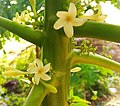Fagraea berteroana
| Fagraea berteroana | |
|---|---|

| |
| Scientific classification | |
| Kingdom: | Plantae |
| Clade: | Tracheophytes |
| Clade: | Angiosperms |
| Clade: | Eudicots |
| Clade: | Asterids |
| Order: | Gentianales |
| Family: | Gentianaceae |
| Genus: | Fagraea |
| Species: | F. berteroana
|
| Binomial name | |
| Fagraea berteroana A.Gray ex Benth. (1856)
| |
| Synonyms[2] | |
|
Synonymy
| |
Fagraea berteroana (orth. variant F. berteriana), commonly known as the pua keni keni, pua kenikeni or perfume flower tree, is a small spreading tree or a large shrub. It is known as the pua-lulu in the Samoan Islands, and as pua in Tonga and Tahiti.[3][4]
It is native to the tropical Pacific, ranging from Queensland and Papuasia (New Guinea, the Bismarck Archipelago, and Solomon Islands) to Micronesia (Caroline Islands, Gilbert Islands, and Marianas), Vanuatu, New Caledonia, Fiji, and parts of Polynesia (Cook Islands, Marquesas, Nauru, Niue, Samoan Islands, Society Islands, Tonga, Tubuai Islands, and Wallis and Futuna).[2]
The ITIS database clarifies the spelling of the name ("Published as "berteriana" in honor of Bertero; correctable to "berteroana,"..).[5]
Description
The plant has quad-angular branches, blunt tipped leaves, and fragrant 7 cm tubular shaped flowers of creamy white, which become yellow with time.
Cultural use
It was introduced to Hawaii, where the flowers are popular for making lei. The tree's name, in Hawaiian, means "ten cent flower", referring to the sale price for a single flower in the past.[6]
Gallery
-
Stem and leaves
-
Flower, fruit and leaves
-
Ripe and unripe fruits
-
Flowers and flower buds
-
Crown
-
White and orange flowers
See also
References
- ^ Botanic Gardens Conservation International (BGCI).; IUCN SSC Global Tree Specialist Group. (2018). "Fagraea berteroana". IUCN Red List of Threatened Species. 2018: e.T135880588A135882129. doi:10.2305/IUCN.UK.2018-2.RLTS.T135880588A135882129.en. Retrieved 8 December 2023.
- ^ a b Fagraea berteroana A.Gray ex Benth. Plants of the World Online. Retrieved 7 December 2023.
- ^ "Pua". Te Māra Reo: The Language Garden. Benton Family Trust. 2023.
- ^ Whistler, W. Arthur (1978). "Vegetation of the montane region of Savai'i" (PDF). Pacific Science. 32 (1). University Press of Hawai'i: 89. Retrieved 10 July 2010.
- ^ ITIS database entry for Fagraea berteroana
- ^ Mary Kawena Pukui; Samuel Hoyt Elbert (2003). "lookup of Pua kenikeni". in Hawaiian Dictionary. Ulukau, the Hawaiian Electronic Library, University of Hawaii Press.
- Mary Kawena Pukui; Samuel Hoyt Elbert (2003). "lookup of Pua kenikeni". in Hawaiian Dictionary. Ulukau, the Hawaiian Electronic Library, University of Hawaii Press.
- IUCN Red List least concern species
- Fagraea
- Flora of the Caroline Islands
- Flora of the Cook Islands
- Flora of Fiji
- Flora of the Gilbert Islands
- Flora of the Mariana Islands
- Flora of the Marquesas Islands
- Flora of Nauru
- Flora of New Caledonia
- Flora of Niue
- Flora of Papuasia
- Flora of Queensland
- Flora of Samoa
- Flora of the Society Islands
- Flora of Tonga
- Flora of the Tubuai Islands
- Flora of Vanuatu
- Flora of Wallis and Futuna
- Plants described in 1856
- Taxa named by George Bentham
- Austronesian agriculture
- Gentianales stubs







